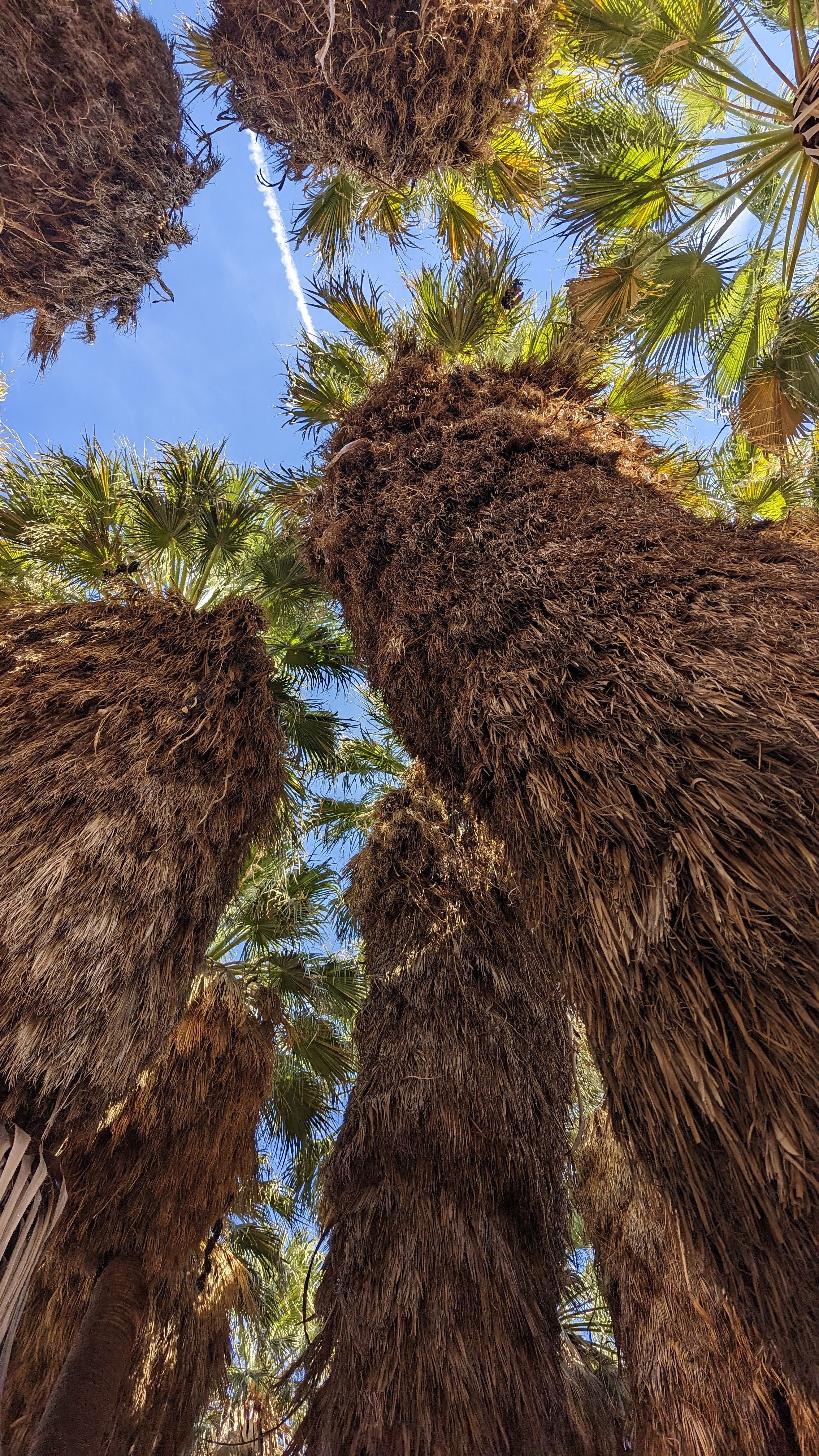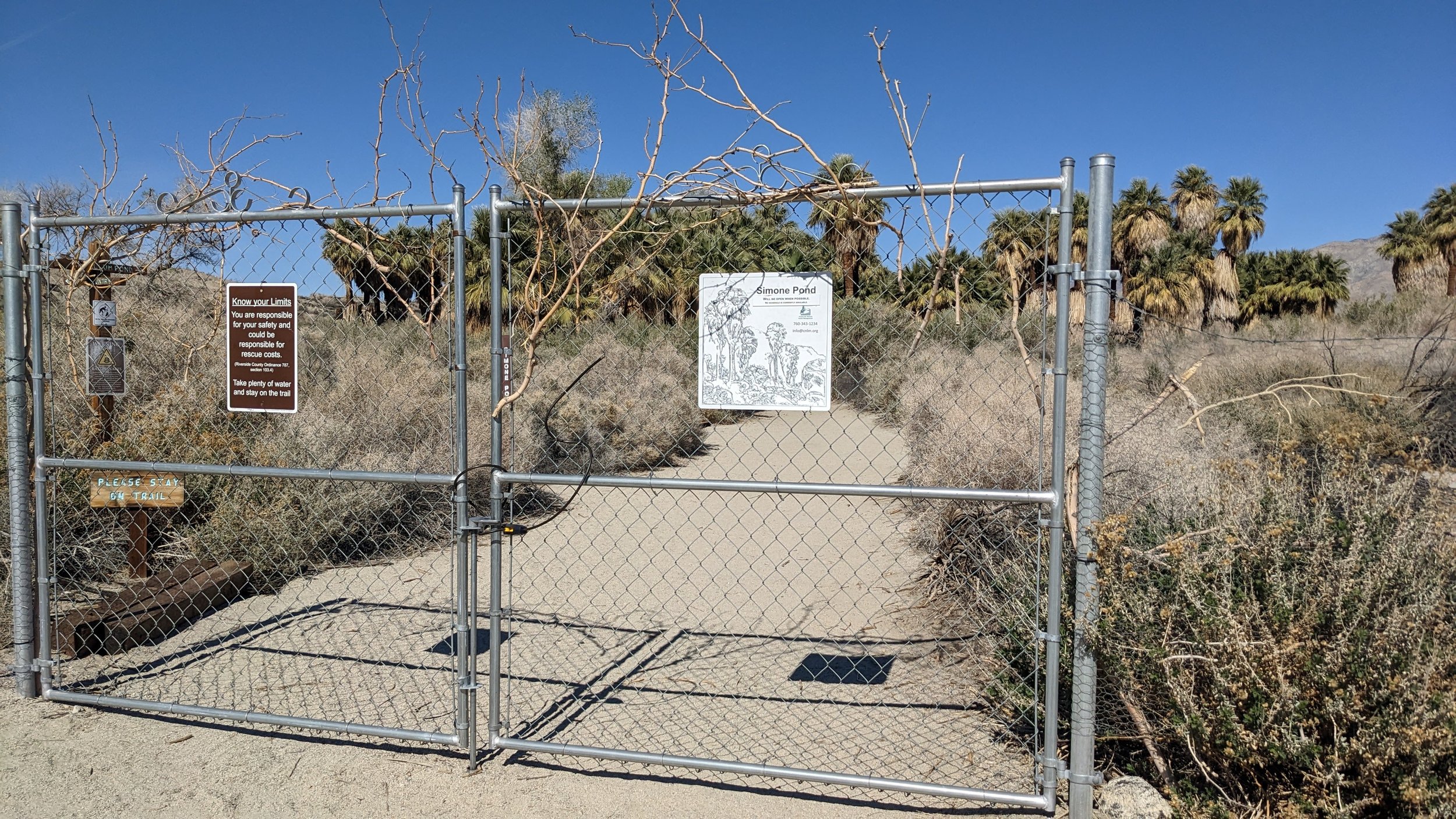Coachella Valley Preserve
One of the MOST POPULAR hikes in the greater Palm Springs area is the Coachella Valley Preserve, and for good reason. When visitors first enter the preserve from the surrounding Colorado Desert, they might feel like we did – like we just stepped foot into a scene from Jurassic Park. Second, the preserve is FREE to explore (although donations are welcome).
Be sure and check out our video for more information on Coachella Valley Preserve (including our hike to the Simone Pond / McCallum Grove).
How to Get to Coachella Valley Preserve
Coachella Valley Preserve is located just a hundred yards or so from Thousand Palms Canyon Road. The small parking lot was closed during each of our visits so we parked on the road. As we approached the preserve, we first encountered the Visitor’s Center located in the Thousand Palms Oasis and a volunteer who explained some of the history and highlights of the Coachella Valley Preserve.
What is the Coachella Valley Preserve
Established in the 1980s to protect and preserve rare and endangered plant and animal species in the area, the Coachella Valley Preserve encompasses over 20,000 acres and features several distinct habitats, including desert wetlands, sand dunes, and rocky canyons. The Coachella Valley Preserve is actually a system of preserves comprised of three separate units (1) Whitewater Floodplain Unit, (2) the Edom Hill/Willow Hole Unit, and (3) the Thousand Palms Unit. The “Thousand Palms Oasis Preserve” within the Thousand Palms Unit is also often referred to as the “Coachella Valley Preserve” —which was confusing to me at first because it is only part of the Coachella Valley Preserve System. The Center for Land Management owns the Thousand Palms Oasis Preserve, while the other major land owners within the Thousand Palms Unit of the Coachella Valley Preserve System are the Bureau of Land Management (BLM), the U.S. Fish and Wildlife Service (USFWS), and the California Department of Fish and Wildlife (CDFW).
For purposes of this blog, I’m generally calling the Thousand Palms Oasis Preserve as the Coachella Valley Preserve because that seems to be how the locals refer to it and that is what the sign says at the main entrance.
The Formation of the Coachella Valley Preserve
What makes the Coachella Valley Preserve unique is that it is located near the San Andreas Fault, which is a tectonic boundary between the North American and Pacific plates. The Coachella Valley Preserve is situated on the north side of the San Andreas Fault, which means that the land on which the Preserve sits is slowly moving northward as the Pacific plate pushes against the North American plate. This movement has resulted in the formation of the San Bernardino Mountains, which rise to the north of the Preserve.
One of the main features of the Coachella Valley Preserve resulting in part from the San Andreas Fault is the presence of several natural springs and underground aquifers that provide water to the desert ecosystem. Through a combination of geological and hydrological processes, those springs and the underground aquifers created the Thousand Palms Oasis, one of the largest and most spectacular palm groves in the region. Large black ravens and other birds cawed and flew among the huge California fan huge palms that form the oasis. These palm trees, which are the only palm species native to California, can grow up to 75 feet tall and can live for over 100 years.
The Thousand Palms Oasis has a number of picnic tables and benches for visitors, and is the starting point for several hiking trails. Most people (like us) came to hike.
Hiking Trail Options at the Coachella Valley Preserve
The McCallum Trail (named after Harold McCallum, who helped establish the Coachella Valley Preserve) is one of the most popular hiking trails at the Coachella Valley Preserve. The 2.5-mile round trip trail begins at the Thousand Palms Oasis, extends through a desert wash, and ends at the McCallum Grove and the Simone Pond (a/k/a McCallum Pond). The latter area features a large stand of California fan palms, which are home to a variety of bird species, including the endangered Southwestern willow flycatcher. We even saw a Great Horned Owl nestled in one of the California fan palms. Along the way, there are several interpretive signs that provide information about the history and ecology of the area.
Pro Tip: Simone Pond/McCallum Grove is only open on days where volunteers are able to monitor visitors (usually just a few hours on the weekends). One of the volunteers told us that a few years ago, the pond’s ecosystem was ruined when people started putting non-native and invasive species into the pond (everything from guppies to tilapia). Indeed, the only fish native to the pond is the Desert Pupfish (Cyprinodon macularis), and the pond was restocked after being poisoned to remove the invasive species and then rehabilitated and restocked with the pupfish.
Coachella Valley Preserve is home to a number of other trails, but the McCallum Trail is by far the one most traveled. Other trail options include:
(1) Moon Country Loop (4.0 miles) – moderate – 310 ft elevation gain
(2) Pushwalla Palms Loop (4.4 miles) – moderate – 705 ft elevation gain
(3) Hidden Palms Loop (1.9 miles) – moderate – 259 ft elevation gain
(4) Horseshoe Palms Loop (4.4 miles) – moderate – 554 ft elevation gain
(5) Herman’s Hike Loop (7.0 miles) – difficult – 1187 ft elevation gain
(6) Willis Palms Loop (4.1 miles) – moderate - 531 ft elevation gain
The Coachella Valley Preserve is open Wednesday through Sunday from 7 a.m. to 5 p.m so it is important to plan enough time for the longer hikes. In addition, it’s also important to bring plenty of water. Drones and dogs (except service dogs) are not allowed on the trails either.
We are very thankful for the volunteers of the Coachella Valley Preserve, who helped us learn more about the history, beauty and diversity of the area. If you are an avid hiker or want to simply learn more about this geological wonder, make the Coachella Valley Preserve a must stop on your visit to the Palm Springs area.
If you are looking for other things to do in the area, check out Redfin’s Desert Oasis Escapes: 16 Must-Experience Activities in Palm Springs. They were kind enough to include this blog in their article!




